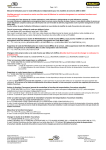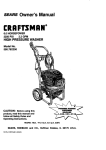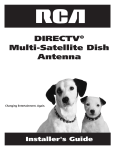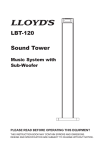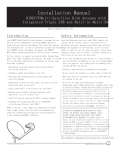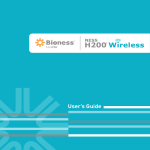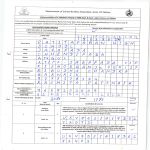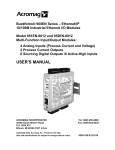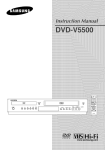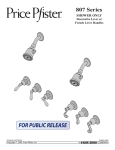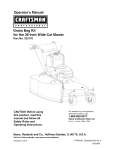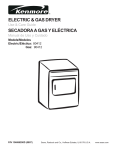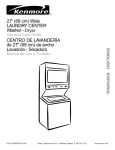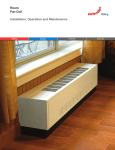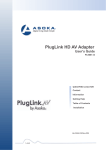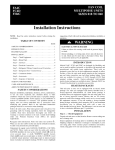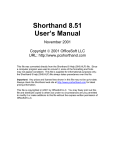Download Winegard/Acer Phase III Triple LNB Dish
Transcript
Winegard/Acer Phase III Triple LNB Dish The following installation manual for the Winegard/Acer Phase III Triple LNB dish is brought to you by the SolidSignal.com Tech Team. For more information about this product and its availability, please click on this page or visit our web site at www.SolidSignal.com. Email: [email protected] I , ~ Introduction Safety Information Your DIRECTV Multi-Satellite Dish antenna is designed for use Local building with up to four independently operating DIRECTV Receivers, antenna and the coaxial cables to be connected to a and electrical Along with your receiver User Manual, this guide will provide grounding the information you'll need to successfully install and operate damage the equipment your DIRECTV System. Throughout the manual, the DIRECTV injury or death to you. For your own safety, follow these Multi-Satellite Dish antenna will be referred to as the "antenna," important electrician For best results, we suggest you read carefully through these pages first before beginning installation. for an individual described, The guide is intended .If experienced in performing the various tasks electrical .Determining U . .Do safe working practices around heights and .11 t rl .Watch sure there are no people, pets, etc. below when you out for power lines which may be overhead, of them with ladders, antenna and tools during installation wall, The Federal Communications Commission (FCC) has ruled that a local government or homeowner's association may not lifting and securing the 20-lb. antenna assembly .Grounding as possible on the ground underground and/or hidden behind walls, keeping safely clear d .11 h I . t h 0 rl 0 es In 0 your ouse .Routing coaxial cable(s) through foundation, d fl tt .' t . II un er- oor, a IC or In erlor wa s .Safely as many functions are working on the roof if there are water pipes, gas lines or wiring d or dangerous to view the attached bubble not install the antenna on a rainy, snowy or windy day .Make hazards a power in your area for assistance: you will be mounting your antenna in a location where it .Perform hidden near where you may drill .sing as well as cause instead. DO NOT risk falling an antenna location with a good southerly a ladder and working on your roof .Observing or the building, may seriously level (see page 6), use a small mirror or plumbing level view of the satellites .Climbing Improper installation safety rules or contact a licensed inspector or will be difficult including: .Determining electrode. codes (NEC) require the prevent the installation of satellite antennas one meter or the antenna and cable(s) as recommended in the National Electric Code (NEC)* NOTE: If you don't feel completely comfortable with these sma"er in diameter, unless legitimate safety restrictions such .' as fire codes are in effect. Call FCC tel: (202) 418-0163; FCC Web sites at http://www.fcc.gov/cgb/satellite.htmi or http://www.fcc.gov/mb/facts/otard.htmi for more information. tasks, simply contact the store where you purchased the system for information on having your system installed by a local authorized DIRECTV installer, DIRECTV~programming is sold separately. To activate DIRECTV programming, please call 1-800-DIRECTV(1-800-347-3288). More programming information is also available at DIRECTV.com. Activation of programmingmay be subject to credit approval and requires valid service address, social security number and/or major credit card. Depositor prepaymentmay be required. In some areas, programming may be provided by members or affiliates of the National Rural Telecommunications Cooperative. *NECis published bythe NationalFireProtection Association, 1 Batterymarch Park, Quincy,Massachusetts. 02269-9101 andmaybeavailableatyourlocalpubliclibrary. .: ~ rj.. '[ ~ ...1 DIRECTV Multi-Satellite DishAntenna .""~-- ,- I- ~!!!~B("""""]1;~;PJ~ \~~~t4':::~ ~ --" ~---i Cj~~~EJ C5:=E~ IISB --i-\-:-;:> J_!Dish Mounting Hardware Multi-Satellite Dish Reflector LNB Arm/Antenna Back Assembly raraiW eeee @ Triple-head, Multi-Satellite @ LNB Mounting Hardware LNB with built-in Multi-Switch for four Independent Outputs ffrc:«llj ~-- I W e e Grounding Screw i (~ EZAUGNTMMast ToolsRequired I Stepsfor Installation 7/16" Nut Driver In the following pages, you'll find step-by-step instructions for: [==~Jr:[J=:::=O Adjustable Wrench (Q~~~~~~~:~5J Screwdriver (Phillips) c===n:o:::=~ Magnetic Compass G) ~ :if - m 8 Determining Coordinatesfor Aiming Antenna page 4 0 Finding Suitable Antenna Site page 5 8 Installin~ EZA~IGNTMMast page 6 G Assembling/Adjusting Antenna on Ground page 7 8 Attaching Antenna to Mast page 7 0 Routing RG 6 Cable(s) page 8 0 Grounding Cable and Antenna page 8 0 Attaching LNB to Antenna page 9 0 Aiming and Fine-tuning Antenna page 9 s EI t . ec rlc d B' t rl an I D ' II I/'/' /' /' /' /' /' /' /' /' /' /,) InformationAlso Included: Troubleshooting Check List for Initial Installation page 11 Loss of Signal/Rain Fade page 12 Installation with Long Cable Run page 12 OptionalAccessories(not included) Typical installation kits (sold separately) include: .Mast base mounting hardware .RG 6 coaxial cable(s) with F connectors .Grounding .6" hardware, grounding wire, wire clips, etc. plumbing level DIRECTV Multi-SatelliteDishAntenna 3 I--l r -:0-1 . DeterminingCoordinates for Aiming Antenna The coordinates (Azimuth, Elevation and 1ilt numbers) are based on your ZIP code and can be determined easily by using your receiver. You will need these numbers for site survey and antenna adjustments. NOTE:The antenna does not need to be installed for this step. Connectyour receiver to the TV --the ~Io ~ ==== : ; ~~S(-! I~~ Depending onyourreceiver Navigate to the antenna installation screen menu. Select installation as an "oval 3-sat" (some receiver brands may call ~odel,yourdisplaymaylcx:k different fromshown.In this it: "tri ple" ' "3 sat location" "."Sat 123" , example, a Southern California ZIPcode"92683"is entered. andreceiveroutputs: .Azimuth:152 .Elevation:50 .lilt: 102 Findyour coordinates Azimuth (horizontal, side-side) \~==~/ Elevation //---~"\ (vertical, up/down) lilt (dishreflectorrotation) 0 Consulting your receiver manual, connect the receiver'svideo or Channel 3/4 outputs to the corresponding TV input. Turn on TV and the receiver. Setthe antennatype I-;=~==:::\ or "Sat ABC"). , , .. Navigateto the antenna-pointing menu screen. Enter your ZIP code, then write down the numbers in space provided below. YourAzimuth YourElevation Yourlilt I ~ ~ Finding Suitable ~ Ant en n a Sit I~ e If you liveon the WestCoast,the If you live on the EastCoast,the satelliteswill be to the south-southeast. satelliteswill be to thesouthwest. ("...~ ~"'~~, ~1800 NOTE:It's important to estimate the cable length at this point. .ru270' The DIRECTVsatellites are located in the southern sky above the Equator. The location for your antenna must have elevation-angle clearance (abovethe horizon) and 18° span clearance (from 101° to 119°) for an unobstructed view to all three satellite locations. Northern border states haveelevation . 30° d h b d t t d 60° SatC,1100with readings toward an sout ern or er s a es towar .Converted Transponders ( ~O~ with a new Multi-Satellite Dish Antenna, be sure to check for the required 18° clearance. If you do not have the required clearance, you should use r ~'--:::--~~71' A suitable antenna site requires an unobstructed view of the southern sky, a stable antenna mounting surface, a distance of 100-ft or less for RG 6 cable from your antenna to your receiver, and grounding nearby. NOTE:If you are replacing an 18" dish . 2 #8, #10,#12 SatA, 1010with Transponders.c::~~ #lto#32 a different location. "=:~=:7 "" ", " "" " ~=:~:;=7 --',', , ", , ' "'" " "" ", SatB, 1190with Transponders #22 to #32 " , ", ',' " 18°-','" ',,' , ','" " ~ No trees,leaves, buildingscan bein theline-of-sight @ between antennaandsatellites. Duetothe manyconfigurations possible, mast-mounting hardware isnot included. Besureyouhavethenecessary mounting hardware beforeyou begin. Optionalmountingkitsareavailable atyourlocalelectronics store.Belowarepotentialmounting sites. StuccoExteriorWall Wooden Rail Chimney Ground DIRECTV Multi-SatelliteDishAntenna 5 I Viewofbubble;:gOntoPofmast @() I) Installing EZAllGNTM Mast - ~ ~ @ Now"you're ready toin~tall theantenna, ma~t atthe \~) \~) ~ location you've chosen In Step 2 and align It to be plumb Right (perfectly 0 the Multi-Satellite @ _) ~- straight up). Plumbing the mast is critical Dish antenna to receive optimal for signals, and failure to align it properly will result in difficulty acquiring signals as well as a greater tendency for signal outages in adverse weather. Mount the base securely The mast base must be sturdy so antenna does not shift under Side viewof bubble level in the mast Wrong Wrong PI various weather conditions and its own weight. Mounting is preferable on wood or masonry. Unsuitable sites may be WTJrI I '=' Right I P==Tl handrail, aluminum or vinyl siding, composite paneling, and I~I fiber/particle/strand "- Mak th b bble I I ti ' t t ' fed I b ' e sure e u jeve rame In IICmas IS sea prope~'Y orpressing down flat on it so the lip of the frame sits snuglyon the top edgeof the mast. boards. CAUTION!When installing mast base, avoid placing finger , ' between mast bottom and base to prevent bel ng pi nched or cut. Align the mast .The EZALIGN Mast pivots up and down, and from side to ." side. A bubble level IS located In the top of the mast to Lookingdown into mast The patentedmast has two slotsat the the bottomthat allowit to move up and down and side to side. Thisaids the centeringthe bubble level even when the mast baseis mountedon an unevensurface. assist in al ignment. .Loosen , the four mast bolts slightly. Then move the mast up/down or twist side-to-side until the bubble in the bubble level is centered as shown at left. CAUTION! If the mast is mounted in a location where it is difficult or dangerous to view the bubble level, use a small mirror or plumbing level instead. DO NOT reach out and risk falling from roof or other high place. Tighten mast bolts When mast is straight up (plumbed), .I;"""""~ ~~~"""" ,-, ,\ " with your other hand. Make sure bolts are secure. You may , ", ,, want to tighten further with an adjustable wrench. ,,/ Tighten (two on Up and DownMovement 0 and while still keeping hold of the mast, tighten the four bolts with a 7/16" nut driver Side to SideMovement .Ass ~ e m b I i n g/ Ad jus Antenna on tin g I Dishattachingto theLNBArm/Antenna BackAssembly . Ground On even ground, attach dish to the LNB Arm/Antenna Back Assembly as shown. Leave off the Triple-head LNB until the antenna is mounted on the mast and you've routed cable through the LNB Arm. Set Tilt Adjustment "" cQ. .At the back of the antenna assembly, loosenthe Tilt nuts and then set the Tilt adjustment according to the coordinate number you obtained in Step 1. .Tighten the Tilt nuts. Do not change the 77ftadjustment again from this point on (even if you could not find the satellite signal during alignment). Unlike the Elevation and A zlmut . h coor d ...the Inates, there IS no need to fine-tune Tilt; ~---~ In thisexamplewehave forSouthern California (ZIPcode~268:3)'." 7i/tsettIngIS 102 .' , I doing so may cause alignment difficulty. For some of the Eastern Seaboard states, however,there maybe an exception: see Step 9, note #2, on page 10. ~ , " 7i/tNuts .1 ,oneshownl Set Elevation Adjustment .At the side of the antenna assembly, loosen the two Elevation nuts (one on each side) and preliminarily set the Elevation adjustment, per the coordinate number obtained in Step 1. .Tighten the Elevation nuts, but not completely. This is a preliminary adjustment which you may have to .' fine-tune later on. --~ In thisexamplewe show ;".7 for Southern California .::/ / (ZIPcode92683),the I Elevation settingis SO' , (usethepositionof the metaledgeto theElevation scale;do not usethewasher or theboltasreference). , e Attaching .Slide Antenna to Metaledge at SO' ~"" ' " " I ; I I ~---~ Mast Elevation Nuts, oneon eachside Azimuth! tClampBolts the back of the antenna assembly onto the top of the mast until it stops at the pivot bolt. If necessary,slightly loosen the two Azimuth/Mast clamp bolts and pivot bolt so the antenna will go on to the mast. .Tighten the two Azimuth/Mast clamp bolts and the pivot bolt just enough so the antenna has only side-to-side movement (rotational swing around the mast) for later Azimuth alignment in Step 9. ;,' ,"", -'"',, ,, ,1 , 1 : ) --', " "I ", ", "-PivotBolt DIRECTV Multi-SatelliteDishAntenna 7 e roun Ing Block ", - ~ \ ,,' , ~JJc1' ~ I I ~ ToReceiver ' -_ ", .\ 1 Beforestarting, inspect the inside of each cable connector for foreign materials and/or short. Make sure that the copper center .) conductor is straight and centered in the connector. , , Runcable from receiver I ' 0- : Verify that there are no wires or pipes blocking the location where you want to feed the coaxial cables into your home. Drill a 1/2" inch hole for each cable. Connect cable to the "Sat In" jack on the back of your receiver. To preventshort, leave receiver unpluggeduntil Step 9. :, '-. I " WaterDrip , Loop You'll route RG 6 cable from your receiverto the cable grounding block, then from the grounding block to the triple-head LNB. I Ca d?le G RoutingRG6 Cable(s} ,,' ...' ,"",~ "'" - . I ToAntenna Connectto groundingblock _I'~IE Mount the grounding block close to the point of cable entry into the house. Connectcable to grounding block as shown. Dualgroundingblock,onereceiverhookupshown rounding. ," Option #1 ~ --' Wire from ~../ Grounding Antenna ' " I , ,'1_BJ~1s__-[" ---' , ') ~ ~' the satellite receiver system and other components from lightning damage. oint .Ground wire can be attached anywhere on the metal part of the antenna, but there is a convenient grounding screw at ,- o 'A" roun Ing..Ire ,, from Antenna G d ,, 0 I I I ~ ,, ,, Cold water pipeonly/ , > , Grounding Wirefrom CableGrounding Block , I I I ---'I ,, , ... ,' (8) grounded metallic service raceway,grounded electric service _"~ ", .,.- I I Grounding the antenna and cable grounding block help protect .Grounding point can be outside metal cold water pipe at point of entry (no gas or hot water pipes), 8-foot ground rod, -' ...' --, Antenna 250 and 810). . Usegrounding wires#10copperor #8 aluminum Option #2 and one side of the mast base. Installation should comply with local codes and the National Electric Code (NEC,Sections --~'Grounding, Wirefrom' 'Cable I 0' " Grounding " , > Coldwater pipeonly , ", " ,,'" Cable ,, , I ,: Grounding ,, equip enclosure, etc. Option#1: Both ground wires go to the same ground point. If the two grounding points are different, a #6 copper wire should be connected between them. Option#2: The dish antenna grounding wire goesto grounding block first, then to the grounding point. I. J e Attaching LNB to Antenna I SatB,SatC, . 1190 1100 SatA, The triple-head LNB has four identical outputs, each 1010 supporting one independently operating receiver. To simplify future installation of additional , , receiver(s), you may want to:' route more for cables to the antenna at thisalignment. point. Only one cable: is needed antenna fine-tuning and ',\:' \,,---~ ! : \ .RG 6 cable from the grounding block can now be routed to " the LNB on your antenna. Attach the triple-head LNB onto the LNB Arm and fasten with included mounting hardware (Philip screws and nuts). Dress cable with enclosed tie wraps, allowing for cable water drip loop if necessary. ~ Aiming ~ Fine-tuning Antenna ' I \\ ' , " """" " ~~ ' ~ upcabJ, es,one I sown h ) to the LNBand H00 kIng " acing Ita h the LNB toAntenna -up tofourcables canbeconnected thisway. " and When you fine-tune the antenna to one satellite, the other two satellites should be aligned automatically. " Plug in and turn on your receiver. .Use Align the Azimuth the on-screen signal strength meter to fine-tune the [ ::J~J .0 antenna. It is important to obtain the strongest signal possible; the higher the signal strength, the less likely you are to experience signal outages during adverse weather. .With a cell phone and house phone, ask someone to relay signal strength values to you, or hook-up a portable TV at the installation site. Your receiver may be equipped with an audible beep tone feature; the higher pitch, the higher the signal. A hand-held signal meter is also an option. Align the Azimuth .Set your on-screen menu to the signal meter mode, on = ~I. ~ ".. ~ Satellite A (1010). a transponder that is unique to Sat A (such as 1 -6,Use16) for your alignment. Point the antenna to a generally southerly direction, I~= ~ .., :~: ...: or use the ::.~: Azimuth number obtained in Step 1 and a compass for a more precise starting point. .Very slowly rotating the antenna around the mast a few degrees at a time, pause 3 -5 seconds in between for signal strength meter update. You should be able to find the satellite signal first and then the signal peak, indicated on your screen. Once you sweep through the peak-signal point " I " I on the screen, stop. You may want to swing past the peak point a couple of times to make sure. .Mark the mast and antenna bracket point with a pencil. I : ',' Pencil Marks' : ", " " '-- -- " , DIRECTV Multi-SatelliteDishAntenna 9 I Verify Azimuth alignment - Switch to Sat B (119°) on your on-screen menu, using J Transponders 23, 25, 29 or 31. Verify that signal is also peaked at 119° by very slightly rotating the antenna around \ ~:~/ the penciled marking on the mast. Once satisfied, tighten the two Azimuth/Mast clamp bolts. [ ~EI NOTE: Sat B (119°) signal strength may read different than Sat A (101°) signal strength, depending on the satellite transmission patterns in the area. You only need to see .0 VerifyAzimuth whether Sat B (119°) Alignment is peaked and not try to compare signal strength numbers. It's OK to be close but not at the peaks for both locations simultaneously. Fine-tune theElevation Use Sat B (119°) or Sat A (101°) on-screen signal meter. While holding the LNB Arm, slightly loosen the two Elevation nuts. ~ = I0 ,. ...;, ~ I~ = Move it up/down slightly and observe the signal strength on the screen. Find the peak and tighten the two Elevation nuts. .6 Verify satellite signals ~~: Confirm the final signal-peak readings at all three satellite ..locations. Sat C (110°, Transponders 8,10 and 12.) should be aligned automatically. NOTE 1: Occasionally, you may see a transponder (101°), / --~\ Sat B (119°) or Sat C (110°) possible that this transponder programming is reserved for upcoming expansion. Switch to other transpo~ders same satellite at the location to verify that you have good readings and that your antenna alignment Fine-tunethe at Sat A not active, it is is satisfactory. NOTE2: In most of the U.S., the Tilt Adjustment should be Elevation fixed. However, because of large Tilt angle to 119° satellite in Eastern Seaboard states, a small amount of Tilt fine-tuning adjustment may improve 119° signal strength without significantly changing 101° signal reading. For these states, the following Tilt fine-tuning procedures are recommended: 1. Follow alignment procedures from Step 1 through Step 9; tighten Elevation and Mast clamp bolts. 2. Fine-tune Tilt Adjustment first by +3 degrees and then -3 degrees. Tilt is optimized --signal ~ 10 ~ .,"...' I~ ...optimized 'B" i~g @ when you see the 1010 reading essentially unchanged and 119° signal strength improved by several points. Set Tilt to the point and tighten Tilt nuts. I Troubleshooting CheckListfor Initial Installation If the signal is not found, be sure the receiver user manual and the antenna installation D Make sure all cable connections are correct and each connection D D is seated/tightened D properly. - manual have been properly followed. Check to: Your triple-head LNB depends on the receiver to supply power; the longer the cable length to the LNB, the greater Inspect the inside of each cable connector for dirt or the DC voltage drop. Your receiver depends on the antenna to supply signal; the longer the cable length, the greater possible connector to case/shield short. the signal amplitude attenuation. Therefore, RG 6 cable Verify the Azimuth, length much longer than 100 feet (from each the receiver to the antenna) should be avoided. Elevation and 1ilt angles for your location by ZIP code. D D D Make sure the 1ilt and Elevation pointers are aligned RG 6 cable with solid copper center conductor is highly recommended because it has much lower DC voltage drop correctly to the scales. Do not use washer or bolt as compared to RG 6 cable with a copper-coated, steel center reference. conductor. Make sure the 1ilt adjustment is not changed from the D recommended setting for the antenna location. D The mast not being plumb/up of alignment D RG 6 coaxial cable must be used. Make sure the bubble level frame inside the mast is seated properly, then check the mast alignment again. straight D is a major cause additional DC drops and signal amplitude Remove existing TV-specific components, attenuation. to the basic D may not work with the satellite signal and they may be in Make sure the satellite cable is connected to the "Sat In" jack, not the "Antenna In" jack. The "Antenna the wall where you can't see them. When in doubt, run RG at the back of the receiver is for off-air antenna 6 cable directly to your receiver. cable TV input, Make sure there are no obstructions may Remove such components, go back to the basic connections called out in this manual and re-verify. such as TV connections called out in this guide. Such components D Some after-market, off-the-shelf add-on components not be as advertised. They might not work or could cause difficulty. splitter, etc; reduce the installation Standard RG 59 cable causes too much DC drop and signal drop; it can not be used to pass the satellite signal. (trees, buildings, D input or In you live in a state on the Eastern Seaboard, you may windows, corner or overhang of your roof, your body or need to fine-tune your 1ilt Adjustment. hands) -the from NOTE 2, page 10, signal does not pass leaves, branches, In" jack Follow directions glass, etc, Also, keep in mind the 18° span clearance to receive all three satellite locations. This required D D If all are done correctly but the signal is still not found, clearance may also mean you'll need to consider a new change the Elevation adjustment location when replacing an old 18" dish with this new (:I: 2°, then :I: 4° from the called-for Multi-Satellite the procedure. Drsh Antenna. of the antenna slightly setting) and repeat Make sure the Access Card from your receiver is fully inserted into the Access Card slot and oriented correctly. DIRECTV Multi-SatelliteDishAntenna 11 I ~ ~ Fade .The satellite signal may be lost temporarily due to unusually heavy rainfall. An optimally aligned antenna, along with the shortest possible cable run, minimizes £=:~=:7 "'" Loss of Signal/Rain " the chances of "rain fade." .Make sure the antenna is mounted securely to prevent it from being blown out of alignment in a heavywind. [fI]~ --away -~- .Heavy snow accumulation on the LNB and the antenna may reduce the satellite signal strength; snow should be swept as soon as possible. .Tree foliage growth into antenna's line-of-sight to the satellite may result in gradual loss of picture. Installation / / with Long Cable Run .For installations where the RG 6 cable runs from the receiver(s)to the LNB far exceeds 100 feet (150 feet or more), as encountered in a commercial or multi-dwelling building, you need to use an AC power booster module to bias the LNB. .You will also need an additional RF signal amplifier to compensate the signal amplitude loss. Otherwise,your antenna and receiver may not work properly and be subject to frequent outages in adverseweather. Contact a professional concerning such installations. @ 7/29/02REV.1 @2(XJ2DIRECTV, Inc. DIRECTV and the CycloneDesignlogo,DIRECTV PARATODOSand EZALiGNare trademarksof DIRECTV, Inc., a unit of HughesElectronicsCorporation. 07/0212~29ENG.0 ~













